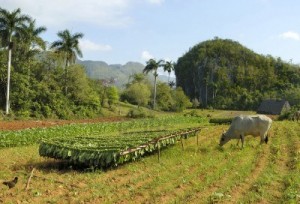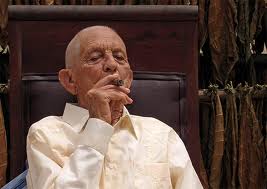The bounties of the Cuban tobacco made it to be recognized the best in the world and this recognition to our odd product placed on the goal of every good smoker.
Profits generated by the smoking, extended by the presence of cigar in the world market, aroused the greed of rulers, merchants and entrepreneurs. That greed led in some countries the government monopoly of snuff and other led to the emergence of a domestic industry, protected by high customs duties, excise taxes and all kinds of provisions that impede imports of Cuban snuff.
… As in any case reached an equal or similar product, competitors followed the path cigar illegal counterfeits and false indications of source. Plagiarized, sometimes with the complicity of their governments, Cuban trademarks and appellations of origin in order to simulate a local industry that had nothing to do with the Cuban snuff, which in many cases not even used as feedstock.
The counterfeit cigar started early. This made the businessmen grouped in the Union of Manufacturers of Havana obtain Snuff by Royal Order of 27 March 1889 the right to ensure the provenance of its products through a sealed whose use was reserved exclusively to the factory owners. That seals was replaced on July 16, 1912 by a government guarantee seals of Cuba, created by an act driven by Luis Valdes parliamentary Carrero, who had come to the House of Representatives from the ranks of the cigar.
The Cuban cigar industry was reorganized from 1827, once established in the Island of free trade and then reduced domestic taxes levied to the product.
Now there were two types of tobaccos. The so-called “royalty”, high quality and high price, and the “common Millar” inferior and cheap. The reorganization of the industry made that producers pay more attention to tobacco for “royalty”. We recorded the first brands to protect the product and began to pay particular attention to cigars for export.
Where will ?
… The peculiarities of each market and the taste of the cigar smokers made, and distinguished by their origin, began to qualify from the area had been harvested.
Several growing areas exist in Cuba. The Vuelta Abajo region corresponds to the western province of Pinar del Rio. Part of an imaginary line drawn from north to south, from Consolacion to Rio Hondo, through Herradura, and Consolation up North, Mantua, Pinar del Rio, Viñales, Guane, San Juan y Martinez, San Luis and South Consolation . This territory is subdivided into five divisions: North Coast, Lomas, Llano, Auction-Guane and South Coast. Terms of San Juan y Martinez and San Luis correspond to Llano, and there are the most famous of snuff vegas world.
Semi Vuelta area is located in the province of Pinar del Rio also from Herradura to Las Martinas, while the party area is located in Havana. They form part of the territories of Alquízar, Bejucal, Caimito of Guayabal, Guines, Guira de Melena, Health, Madruga, San Antonio de los Baños and Santiago de las Vegas and also Guanajay and Artemis.
The area is the largest tobacco from Vuelta Arriba or Remedies. It spans three regions of central provinces and reaches Ciego de Avila and Camaguey. In the eastern zone are areas of Alto Songo, Bayamo, Jiguaní, Mayari and Sagua de Tánamo.
The snuff harvested in each of these areas has its peculiarities. In Vuelta Abajo are obtained for thinner layers of high quality cigars. The Semi Vuelta produces good cloaks. The productions of the Vuelta Arriba, in high demand in the U.S. market before the implementation of the blockade., Still demand abroad and domestic trade, as the crops of the eastern zone.
…. This is a story, not the story, of a genuinely Cuban industry. Much satisfy the author know that by reading it, the person learned something new and satisfaction would be greater if he knew he enjoyed it also. It remains for me to give advice. Say no to smoking. If you have never smoked, do not. And if you smoke, quit because smoking will always count. It’s hard trying. But remember that the longest journey begins with the first step.
Sources:CiroBianchiRoss/Excerpts/InternetPhotos/www.thecubanhistory.com
Una Historia del Tabaco/ TCH – Arnoldo Varona, Editor
UNA HISTORIA DEL TABACO CUBANO
Las bondades del tabaco cubano hicieron que se le reconociese como el mejor del mundo y ese reconocimiento situó a nuestro impar producto en la meta de todo buen fumador.
Las utilidades que generaba el hábito de fumar, extendido por la presencia del habano en el mercado mundial, despertaron la codicia de gobernantes, comerciantes y empresarios. Esa codicia dio origen en algunos países al monopolio gubernamental del tabaco y en otros propició el surgimiento de una industria doméstica, amparada en elevados derechos de Aduana, impuestos internos y toda clase de disposiciones que dificultaban las importaciones del tabaco cubano.
… Como en ningún caso lograron un producto igual ni parecido, siguieron los competidores del habano la vía ilegal de las falsificaciones y de las falsas indicaciones de procedencia. Plagiaron, con la complicidad a veces de sus gobiernos respectivos, marcas cubanas y denominaciones de origen a fin de simular una industria local que nada tenía que ver con el tabaco cubano, que en muchos casos ni siquiera utilizaba como materia prima.
La falsificación del habano comenzó temprano. Esto hizo que los empresarios agrupados en la Unión de Fabricantes de Tabaco de La Habana obtuvieran por Real Orden de 27 de marzo de 1889 el derecho de garantizar la procedencia de sus producciones mediante una precinta cuyo uso se reservaba en exclusiva a los dueños de fábricas. Esa precinta fue sustituida el 16 de julio de 1912 por una precinta de garantía del gobierno de Cuba, creada por una ley impulsada por el parlamentario Luis Valdés Carrero, que había llegado a la Cámara de Representantes desde las filas de los tabaqueros.
La industria tabacalera cubana se reorganizó a partir de 1827, una vez instituida en la Isla la libertad de comercio y luego de reducirse los impuestos internos que gravaban al producto.
Había entonces dos tipos de tabacos. Los llamados de “regalía”, de mayor calidad y alto precio, y los “de millar común”, inferiores y baratos. La reorganización de la industria hizo que los productores prestaran mayor atención a los tabacos de “regalía”. Se registraron las primeras marcas para amparar el producto y empezó a prestarse especial atención al habano destinado a la exportación.
De donde serán?
…Las peculiaridades de cada mercado y el gusto de los fumadores hicieron que el habano, distinguido ya por su procedencia, comenzara a clasificarse a partir de la zona donde había sido cosechado.
Varias zonas de cultivo existen en Cuba. La de Vuelta Abajo corresponde a la región más occidental de la provincia de Pinar del Río. Parte de una línea imaginaria, trazada de norte a sur, desde Consolación hasta Río Hondo, pasando por Herradura, y la conforman Consolación del Norte, Mantua, Pinar del Río, Viñales, Guane, San Juan y Martínez, San Luis y Consolación del Sur. Este territorio se subdivide a su vez en cinco subzonas: Costa Norte, Lomas, Llano, Remates-Guane y Costa Sur. Los términos de San Juan y Martínez y San Luis corresponden al Llano, y allí se encuentran las más afamadas vegas de tabaco del mundo.
La zona de Semi Vuelta se ubica asimismo en la provincia pinareña, desde Herradura hasta Las Martinas, en tanto que la zona de Partido se localiza en La Habana. Forman parte de ella los territorios de Alquízar, Bejucal, Caimito del Guayabal, Güines, Güira de Melena, La Salud, Madruga, San Antonio de los Baños y Santiago de las Vegas y también los de Guanajay y Artemisa.
La zona tabacalera más extensa es la de Vuelta Arriba o Remedios. Se extiende por regiones de las tres provincias centrales y llega a Ciego de Ávila y Camagüey. A la zona de Oriente corresponden las áreas de Alto Songo, Bayamo, Jiguaní, Mayarí y Sagua de Tánamo.
El tabaco cosechado en cada una de esas zonas tiene sus peculiaridades. En Vuelta Abajo se obtienen las capas más finas para las vitolas de alta calidad. La Semi Vuelta produce buenos capotes. Las producciones de la Vuelta Arriba, muy solicitadas por el mercado norteamericano antes de la implantación del bloqueo., siguen teniendo demanda en el exterior y en el comercio nacional, al igual que las cosechas de la zona de Oriente.
….Esta es una historia, no la historia, de una industria genuinamente cubana. Mucho satisfaría al autor saber que al leerla, el interesado aprendió algo nuevo y su satisfacción sería mayor si supiera que además la disfrutó. Solo me resta dar un consejo. Diga no al hábito de fumar. Si nunca ha fumado, no lo haga. Y si fuma, deje de hacerlo porque el fumar siempre le pasará la cuenta. Es difícil proponérselo. Pero recuerde que el camino más largo comienza por el primer paso.
Sources:CiroBianchiRoss/Excerpts/InternetPhotos/www.thecubanhistory.com
Una Historia del Tabaco/ TCH – Arnoldo Varona, Editor






